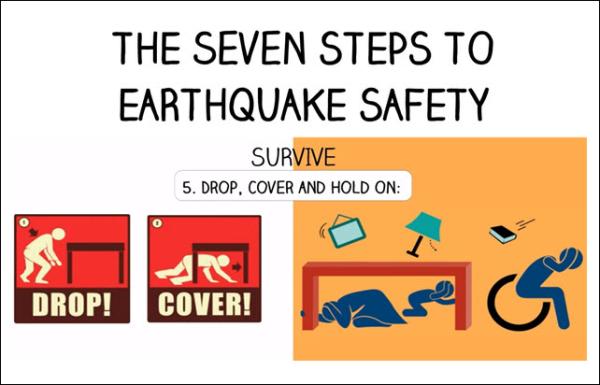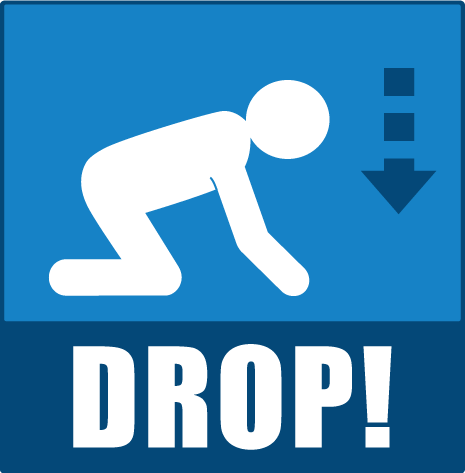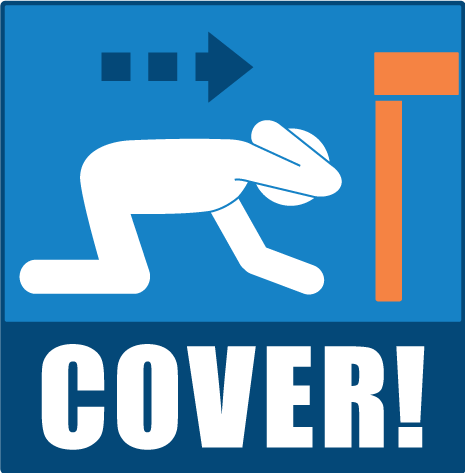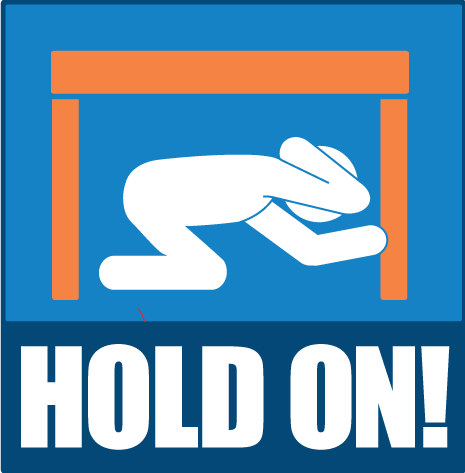Learn What to do in an Earthquake
Imagine this: you’re going about your daily business—working at the office, driving to the store, or walking in your neighborhood—when suddenly the ground beneath you starts moving. After the initial surprise, you realize: you’re in an earthquake.
What should you do?
If You Are Inside A Home Or Building during an Earthquake
First things first: if you feel an earthquake, resist the urge to run outside. Here in California, modern buildings are designed to withstand large earthquakes, but windows can shatter onto the street below, and exterior masonry may fall off as well. This means there’s a greater chance you’ll be hurt if you’re near a building during an earthquake than if you’re in it. Stay put.
What to Do During An Earthquake If You Are Outside
What if you’re outside? In that case, get away from trees and power lines (both of which may topple), as well as buildings (which likely won’t fall but may drop debris on you). If you can shelter in place, do so.
If You Are In Your Car Or Driving and an Earthquake Strikes
Follow the advice from our ShakeOut friends:
- Pull over to the side of the road, stop, and set the parking brake.
- Avoid overpasses, bridges, power lines, signs and other hazards.
- Stay inside the vehicle until the shaking stops, then proceed carefully by avoiding fallen debris, cracked or shifted payment, and emergency vehicles.
- If a power line falls on the car, stay inside until a trained person removes the wire.
Learn what to do in other unique and specific earthquake situations, so you can be safe wherever you are when the earth shakes.
Protect yourself during earthquake shaking: Drop, Cover, and Hold On
The best way to shelter in place is to drop, cover, and hold on. When the quake starts, drop to the floor as soon as you can (it’s easy to get thrown off your feet and injured if you try to run while the building is moving). If a table or other form of cover is nearby, then move quickly (crawling works) to get underneath it. Finally, crouch in position, with one arm over your neck and head, and another holding on to the table leg.
In MOST situations, you will reduce your chance of injury if you:
| Drop, Cover, and Hold On | ||
|---|---|---|
|
|
DROP: Wherever you are, drop onto your hands and knees. This position helps keep you from being knocked down, and allows you to crawl to shelter. |
|
|
|
COVER: With one arm and hand, cover your head and neck. If there is a nearby desk or table, crawl under it for shelter. If there’s no shelter, crawl next to an interior wall away from windows. |
|
|
|
HOLD ON: If you’re under shelter, hold onto it with one hand. If there’s no shelter, hold on to your head and neck with both arms and hands. |
|
Want more information on why earthquake experts recommend this as the best way to protect yourself during an earthquake? Read ShakeOut's special report!
What not to do in an earthquake
There's a lot of misinformation out there, and it's understandable to be confused. Now that you know what to do, make sure you also know what not to do:
- Do not run outside
- Do: Shelter in place using Drop, Cover and Hold On
- Do not get in a doorway
- Do: Shelter in place under a table. In modern houses and buildings, doorways are no safer, and they do not protect you from flying or falling objects.
- Do not make phone calls
- Do: Text. After experiencing a large earthquake, it’s natural to want to reach out to friends and family. A text will have a better chance of getting through than a phone call, which is more likely to experience network congestion. Too many calls can overload the communications grid, making it harder for first responders to get their calls. Everyone will be safer if you limit your calls after an earthquake. And if you don't have power, you'll want to save your phone's battery power for when you need it most.
- Likewise, don’t call 911 unless you’re experiencing a true emergency. Unless someone is hurt, leave that system open for first responders to get to the injured as quickly as possible.
Easy Ways to Prepare for an Earthquake
With a little bit of preparation, you can avoid some of the biggest problems associated with earthquakes, and get back on your feet more quickly after a major event.
For example, it’s a good idea to keep a flashlight and a pair of shoes next to your bed. This way, if a quake hits in the middle of the night, knocking out power, you’ll be able to make your way through a darkened house after the quake.
And don’t forget to put on those shoes. One of the most common injuries seen after a quake is cut feet, caused when people walk or run barefoot over broken glass and other sharp objects. So keep a pair of shoes near you at night, and make sure your children do too.
If you live in Los Angeles County, you may also want to download the ShakeAlertLA app. This mobile app can alert you to an impending earthquake up to a minute before it arrives.
Have Extra Supplies on Hand
A strong earthquake can knock out infrastructure, including electricity and water. Your water supply may be compromised. Keep several gallons of water on hand, just in case. It’s also a good idea to have a stock of canned goods—and an easy-to-reach can opener.
Also, consider packing two go bags—one for your home, and another for your car—in case you have to evacuate. These bags should contain essential supplies like water, first aid kits, and copies of important documents. Keep the bag in an easily accessible place, so you can literally grab it and go.
Finally, consider keeping cash on hand. If electricity is knocked out in your city or town, credit card readers and ATMs won’t work. You’ll need to pay in cash.
Protect Your Home by lowering its risk of structural damage from an earthquake
In addition to the personal preparedness steps mentioned above, homeowners can take steps now to protect their houses and personal property. If you own a house that was built before 1980, it may benefit from a seismic retrofit, especially if it sits on a raised foundation. A retrofit typically costs $3,000 to $6,000. That’s not a small amount, but it’s far less than the hundreds of thousands of dollars it costs to rebuild a house that’s fallen off its foundation.
A seismic retrofit is even more cost-effective if you take advantage of one of California’s two retrofit grant programs, Earthquake Brace + Bolt (EBB) and CEA Brace + Bolt (CEA BB). These programs both provide grants of up to $3,000 to homeowners in higher-earthquake-risk ZIP Codes to help pay for seismic retrofitting of older houses. CEA BB is specifically for CEA earthquake insurance policyholders; EBB does not require participants to have earthquake insurance. But if you live in California, where there is always a risk of earthquakes, getting earthquake insurance is always a beneficial choice.
Did you know that California homeowners policies do not cover earthquake damage?
Many residents don’t realize that their homeowners policy does not cover earthquake damage. You need a separate earthquake insurance policy to protect your house and your belongings, or to pay for you to live elsewhere if earthquake damage or a civil authority keeps you out of your home.
CEA offers insurance as part of our goal to make California and its residents better prepared for large earthquakes. In fact, we are the largest provider of earthquake insurance in California, with more than
Protect your finances and your biggest asset. See how earthquake insurance can help protect your house, mobilehome, condo unit, or apartment by visiting CEA’s policy page.
How to File a Claim after an Earthquake
If you have CEA earthquake insurance, you can make use of it right away after an earthquake. Just start by contacting your residential insurer to report your loss. Remember that CEA policies offer coverage for emergency repairs, so you can take immediate steps to secure your belongings and avoid further damage.
And you never have to pay any deductible out of pocket in order to receive a claim check. CEA simply takes the total covered damage amount, subtracts your coverage deductible, and pays the full amount of your covered loss up to the applicable coverage limit. If your covered damage exceeds your deductible, you receive a claim payment. You don’t have to pay up front or out-of-pocket before receiving your claim payment.
Finally, our Loss of Use option, which will help cover your additional living expenses if you can’t return to your home right away, comes with no deductible.
NOTE: in order to get the most from your insurance, be sure to document your claim by taking photos and videos of earthquake damage to your house and its contents before you clean up. And be sure to record all names, dates, phone numbers, and email addresses from all your insurance-related communications. Finally, hold on to all your receipts for earthquake-related expenses.
Prepare Now to Stay Safe
According to the US Geological Survey (USGS), there’s a greater than 99% chance that California will experience a M6.7 or higher earthquake. But as seismologist Lucy Jones has pointed out, while the earthquake is inevitable, the disaster is not. And whether or not an earthquake becomes a disaster boils down to one word: preparation.
Make sure you’re ready for the next big earthquake. Check out the preparedness resources offered by CEA and our various partners; retrofit your older home, if needed; and buy earthquake insurance to protect your finances.
Learn The Seven Steps to Earthquake Safety

The Seven Steps To Earthquake Safety
Use the Cal OES MyHazards tool to learn about the types of natural hazards in your area. You can also learn more about modifications to the steps for people with disabilities and other access or functional needs. And, always have the steps on hand! Download the Seven Steps to Earthquake Safety (PDF).



